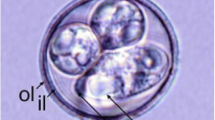Abstract
A new Isospora (Apicomplexa:Eimeriidae) species is described from a silvereye (Zosterops lateralis) in Western Australia. Sporulated oocysts of this species are spherical, 24.2 (23.1–25.2) × 23.3 (22.8–23.9) μm, with a shape index (length/width) of 1.02, and with a smooth bi-layered oocyst wall, 1.2 μm thick (outer layer 0.9 μm, inner 0.3 μm). A polar granule is present, but the oocyst residuum and a micropyle are absent. The ovoid-shaped sporocysts are 16.1 (15.7–17.3) × 10.5 (15.7–17.3) μm and have a shape index of 1.53. A hemidome-shaped Stieda and a rectangular-shaped substieda body are present. A sporocyst residuum is present and composed of numerous granules of different sizes scattered among the sporozoites. The oocysts from this isolate are morphologically different from those of all known Isospora spp. This coccidian parasite was molecularly characterised at the 18S, 28S ribosomal RNA and the mitochondrial cytochrome oxidase (COI) gene. At the 18S locus, based on 1210 bp of sequence, this new isolate exhibited 99.9, 99.8, 99.7 and 99.5% similarity to I. sp. MAH-2013a (KF648870) from a superb starling (Lamprotornis superbus) in Canada, I. sp. MS-2003 (AY33157) from a Southern cape sparrow (Plocepasser mahali) in America, I. sp. Tokyo (AB75786) from Japan and I. sp. respectively. Further analysis of a subgroup of 300 bp long 18S sequences (n = 11), including I. anthochaerae and the other three Isospora characterised from birds in Western Australia, revealed that I. butcherae n. sp. exhibited 98.3% similarity to both I. sp. MAH-2013a (KF648870) and I. MS-2003 (AY33171). At the 28S locus, this new isolate exhibited 97.3% similarity with I. sp. MS-2003 from a California towhee (Melozone crissalis). At the COI locus, this new isolate exhibited 99.8% similarity to I. neochmiae from a red-browed finch. Based on morphological and molecular data, this isolate is a new species of Isospora, which is named Isospora butcherae n. sp. after Mrs. June Butcher for her lifelong dedication as a wildlife rehabilitator.

ᅟ




Similar content being viewed by others
References
Berto BP, Flausino W, McIntosh D, Teixeira-Filho WL, Lopes CWG (2011) Coccidia of New World passerine birds (Aves: Passeriformes): a review of Eimeria Schneider, 1875 and Isospora Schneider, 1881 (Apicomplexa: Eimeriidae). Syst Parasitol 80:159–204
Berto BP, Ferreira I, Flausino W, Teixeira-Filho WL, Lopes CWG (2013) Isospora canaria box, 1975 (Apicomplexa: Eimeriidae) from canaries Serinus canaria Linnaeus (Passeriformes: Fringillidae) in Brazil. Syst Parasitol 85:49–53
Box ED (1975) Exogenous stages of Isospora serini (Aragao, 1933) and Isospora canaria sp. n. in the canary (Serinus canarius, L.) J Protozoal 22:165–169
Carreno RA, Barta JR (1999) An eimeriid origin of isosporoid coccidia with Stieda bodies as shown by phylogenetic analysis of small subunit ribosomal RNA gene sequences. J Parasitol 85:77–83
Duszynski DW, Upton SJ, Couch L (1999) The coccidia of Passeriformes (Isospora spp.) http://biology.unm.edu/biology/coccidia/passer1.html. Accessed 08 Apr. 2017
Levine ND, Van Riper S, Van Riper C (1980) Five new species of Isospora from Hawaiian birds. J Protozool 27:258–259
Morin-Adeline V, Vogelnest L, Dhand NK, Shiels M, Angus W, Šlapeta J (2011) Afternoon shedding of a new species of Isospora (Apicomplexa) in the endangered regent honeyeater (Xanthomyza phrygia). Parasitology 138:713–724
Olson VA, Gissing GJ, Barta JR, Middleton AL (1998) A new Isospora sp. from Carduelis tristis (Aves: Fringillidae) from Ontario, Canada. J Parasitol 84:153–156
Pizzey G, Knight F (2007) The field guide to the birds of Australia. Harper Collins Publishers Pty Ltd.
Schoener ER, Alley MR, Howe L, Castro I (2013) Coccidia species in endemic and native New Zealand passerines. Parasitol Res 112:2027–2036
Schrenzel MD, Maalouf GA, Gaffney PM, Tokarz D, Keener LL, McClure D, Griffey S, McAloose D, Rideout BA (2005) Molecular characterization of isosporoid coccidia (Isospora and Atoxoplasma spp.) in passerine birds. J Parasitol 91:635–647
Speer CA, Duszynski DW (1975) Fine structure of the oocyst walls of Isospora serini and Isospora canaria and excystation of Isospora serini from the canary, Serinus canarius L. J Protozool 22:476–481
Yang R, Fenwick S, Potter A, Elliot A, Power M, Beveridge I, Ryan U (2012) Molecular characterisation of Eimeria species in Macropods. Exp Parasitol 132:216–221
Yang R, Murphy C, Song Y, Ng-Hublin J, Estcourt A, Hijjawi N, Chalmers R, Hadfield S, Bath A, Gordon C, Ryan U (2013) Specific and quantitative detection and identification of Cryptosporidium hominis and C. parvum in clinical and environmental samples. Exp Parasitol 135:142–147
Yang R, Brice B, Ryan U (2014) Isospora anthochaerae n. sp. from a Red Wattlebird (Anthochaera carunculata) (Passeriformes: Meliphagidae) in Western Australia. Exp Parasitol 140:1–7
Yang R, Brice B, Habsi KA, Elliot A, Ryan U (2015a) Isospora streperae n. sp. (Apicomplexa: Eimeriidae) from a grey currawong (Strepera versicolour plumbea) (Passeriformes: Artamidae) in Western Australia. Exp Parasitol 151-152C:49–55
Yang R, Brice B, Ryan U (2015b) Isospora serinuse n. sp. (Apicomplexa: Eimeriidae) from a domestic canary (Serinus canaria forma domestica) (Passeriformes: Fringillidae) in Western Australia. Exp Parasitol 159:59–66
Yang R, Brice B, Jian F, Ryan U (2016a) Morphological and molecular characterization of Isospora manorinae n. sp. in a yellow-throated miner (Manorina flavigula wayensis) (Gould, 1840). Exp Parasitol 163:16–23
Yang R, Brice B, Ryan U (2016b) Morphological and molecular characterization of Isospora neochmiae n. sp. in a captive-bred red-browed finch (Neochmia temporalis) (Latham, 1802). Exp Parasitol 166:181–188
Acknowledgments
The authors would like to thank June and Lloyd Butcher for establishing Kanyana Wildlife Rehabilitation Centre. We acknowledge the contribution of the Kanyana volunteers for their dedication in caring for the wildlife at the centre. We are also most grateful to the veterinary and nursing staff at Wattle Grove Veterinary Hospital, Perth, for their care and expert treatment of wildlife.
Author information
Authors and Affiliations
Corresponding author
Additional information
Section Editor: David S. Lindsay
Rights and permissions
About this article
Cite this article
Yang, R., Brice, B., Jian, F. et al. Morphological and molecular characterisation of Isospora butcherae n. sp. in a silvereye (Zosterops lateralis) (Latham, 1801). Parasitol Res 117, 1381–1388 (2018). https://doi.org/10.1007/s00436-018-5808-8
Received:
Accepted:
Published:
Issue Date:
DOI: https://doi.org/10.1007/s00436-018-5808-8




